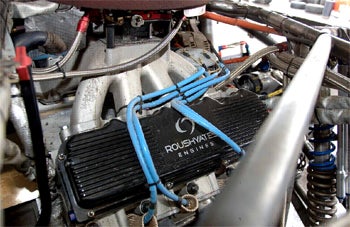Amazing Entry to TORC Series by Roush Yates Engines: Five victories in six starts
 Mooresville, NC. In order to win the race, you must have the equipment to finish the race. As the engine is the core of all such endeavors, it must perform reliably and repeatedly.
Mooresville, NC. In order to win the race, you must have the equipment to finish the race. As the engine is the core of all such endeavors, it must perform reliably and repeatedly.
No one is more acutely aware of this fact than Roush Yates Engines, an amalgam of NASCAR wizards Jack Roush and Robert Yates, known for their construction of 358-cubic-inch engines (operating at 9,600 rpm) as mandated by NASCAR, ARCA, and Craftsman Truck Series, among others.
As of mid-summer 2008, Roush Yates 436-cubic-inch engines have been particularly devastating in the WSORR (World Series of Off-Road Racing) and TORC (The Off-Road Championship Series) domains.
What makes ‘em tick? According to Roush Yates’ Off-Road Engine manager 46-year-old Mike Kasch, “The peak is 900 horsepower and remains fairly constant between 7,400 and 8,200 rpm. Torque climbs to 675 pounds-feet at 6,000 rpm.
“We build the engine packages with aluminum cylinder blocks and heads and manage them with six-stage dry-sump oiling systems. These trucks run much like a road course but with jumps, so they are on and off the throttle as traction allows. Right now, we use the same package for both 2WD and 4WD, other than we advance the cam a slight amount in the 4WD because of the extra pull they get in the lower rpm ranges and especially off the corners,” Kasch said.
What makes these engines so overwhelming is a direct result of two key areas--induction system sophistication and reliability. Indeed, the foundation of the induction system is Yates and his legendary cylinder heads. Dry testing is conducted on no less than three Spintron machines that operate literally around the clock.
The Spintron is a sophisticated engine test rig into which a race motor is mounted. Powered by an AC electric motor, this device spins the race motor through its entire rev range, simulating gear changes, without the engine firing. It records vital data in all critical areas, including valve-train behavior, especially valve lofting as the lifters travel over the camshaft lobes. Moreover, the Spintron accommodates laser tracking of valve movement, contributes video camera investigation, and measures frictional loses.
In the WSORR, Scott Taylor’s 2WD F150 won the 14th annual Borg-Warner Heavy Metal Shootout, a special race that combines both the two- and four-wheel drive classes for a $50,000 winner-take-all purse (the largest in short-course racing).
This was only the second time that a two-wheel drive truck had won the Shootout. Taylor did it both times, first in 2002 with a Roush Performance Engines motor and now with Roush Yates Engines.
In 2009, Roush Yates engines have won five out of six rounds in the TORC series 2WD class. Taylor won rounds two and six while teammate Ricky Johnson took rounds first, third and four. Johnson also finishing second to Taylor in round 2 and has a third and fourth-place finishes in rounds five & six. Ricky Johnson is leading the points and Scott Taylor is in third, 25 points behind and one point out of second place with 10 rounds left to race.


 Your Privacy Choices
Your Privacy Choices